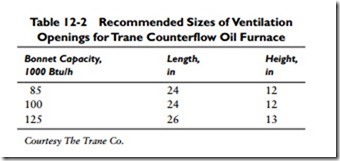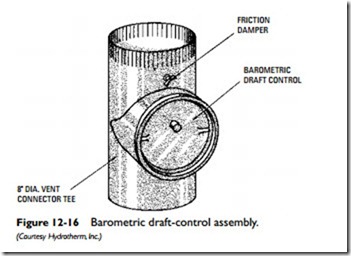Combustion Draft
An oil-fired furnace requires sufficient draft for the proper burning of oil. The average combustion draft is usually 0.02 in wg over the fire (the so-called overfire draft), and between 0.04 and 0.06 in wg draft in the stack (the flue draft) for units having inputs up to 2.0 gph. For higher inputs, 0.06 to 0.08 in wg will be the rule. Always consult the furnace manufacturer’s operating manual first for recommended drafts.
Venting
Oil furnaces use the same methods for venting the products of combustion to the outside air as do gas furnaces, except when the venting method is specifically limited to a particular fuel (for example, Type B gas vents). Additional information about venting methods is contained in Chapter 11, “Gas Furnaces.” The type of venting to be used will be recommended by the furnace manufacturer in the installation literature.
Most high-efficiency (condensing) oil furnaces vent their exhaust gases through a single plastic flue pipe extending from the furnace through a nearby sidewall. The flue vent pipe in these installations is not connected to the chimney.
In some condensing furnace installations, two vents are used. One vent consists of the plastic flue pipe running horizontally from the furnace to the sidewall; the other consists of the conventional chimney and flue liner. Both flue vents remain open during the combustion process.
The strong forced draft produced by a high-static oil burner is sufficient to propel combustion gases through the flue in sidewall- venting installations. Some oil furnaces use a small induced fan installed in the flue. The fan vents the combustion gases through a sidewall vent opening.
Flue Pipe
Use 24-gauge galvanized flue pipe (or its equivalent) for the flue connection between the furnace and the chimney. The horizontal run of flue pipe should slope upward at least 1⁄4 in per running foot. The pitch should not exceed 75 percent of the vertical vent. Locate the unit so that the furnace flue outlet is no more than 10 flue pipe diameters from the chimney connection. If the distance is greater, use the next-size-larger flue pipe.
Insulate the flue pipe when it passes near combustible material. The UL requires that any uninsulated flue pipe be installed with a minimum clearance of 6 in from any combustible materials.
Narrow plastic pipe is used to exhaust the flue gases from mid- efficiency and high-efficiency oil furnaces. The trade names of these plastic vent systems are ULTRAVENT® (gray plastic flue pipe with gray fittings), SELVENT® (black plastic flue pipe with black fit- tings), and PLEXVENT® (black plastic flue pipe with yellow or gray fittings).
Warning
The plastic venting systems of mid-efficiency and high- efficiency oil furnaces installed after 1988 may crack or sepa- rate at the joints and cause carbon monoxide to leak into the house. The entire vent system should be replaced to avoid possible exposure to carbon monoxide.
Barometric Damper
A barometric damper (also called a draft regulator or barometric draft regulator) is a device designed to maintain a proper draft in an oil furnace by automatically reducing (diluting) the chimney draft (that is, the flue draft) to the desired value (Figure 12-16). Its function is similar to that of the draft hood on a gas furnace. It isolates
the oil burner from changes in pressure at the chimney opening by pulling heated warm air into the exhaust.
Draft regulators are recommended on all installations for each oil-fired appliance connected to a chimney unless the appliance is listed for use without one.
Do not use a small draft regulator, because it will not do a satisfactory job. The draft regulator should be installed in the horizontal flue pipe as close as possible to the chimney. When this flue pipe is too short for a satisfactory installation, the draft regulator should be installed in the chimney either above or below the flue pipe entry into the chimney. Some authorities oppose installing the draft regulator in the chimney, but experience has shown that this can be a very satisfactory installation.
Related posts:
Incoming search terms:
- oil pipe mail
- recommended flue draft for oil furnace
- oil furnace draft
- oil burner draft
- Most oil furnaces require a chimney or flue draft of approximately ____
- fuel oil furnaces manufacturers mail
- what guage flue pipe for oil furnace
- what gauge of galvanized steel pipe is used for oil furnace outlet
- reducing draft on boiler chimney
- What kind of draft pipe is used for a furnace
- what should your draft be over fire on oil furnace
- Plastic Pipe Machinery mail
- Oil-burning Furnace Flue HVAC
- draft gauge for oil burner
- oil furnace flue pipe
- draft on oil furnace
- flap on pipe from oil furnace to chimney
- not enough draft on oil furnace
- oil boiler draft
- oil burner manufacturers mail
- oil furnace chimney draft
- oil furnace exhaust fan
- oil furnace flu is back drafting
- what the draft in oil furance

